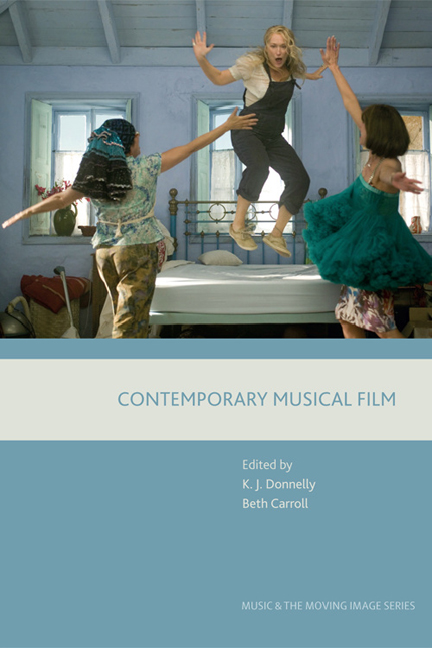Book contents
- Frontmatter
- Contents
- Illustrations
- Contributors
- Introduction: Reimagining the Contemporary Musical in the Twenty-first Century
- PART ONE ORIGINAL MUSICALS
- 1 Aesthetic Absurdities in Takashi Miike's The Happiness of the Katakuris
- 2 Film and the Twilight of Rock (Rock is Dead and Film Killed It): Post-millennial Rock Musicals
- 3 Team America: World Police: Duplicitous Voices of the Socio-political Spy Musical
- 4 The Anti-musical or Generic Affinity: Is there Anything Left to Say?
- 5 ‘Is This Real Enough For You?’: Lyrical Articulation of the Beatles' Songs in Across the Universe
- 6 ‘Love Is an Open Door’: Revising and Repeating Disney's Musical Tropes in Frozen
- PART TWO STAGE TO SCREEN
- PART THREE MUSICALS BY ANOTHER NAME
- Index
6 - ‘Love Is an Open Door’: Revising and Repeating Disney's Musical Tropes in Frozen
from PART ONE - ORIGINAL MUSICALS
Published online by Cambridge University Press: 03 January 2018
- Frontmatter
- Contents
- Illustrations
- Contributors
- Introduction: Reimagining the Contemporary Musical in the Twenty-first Century
- PART ONE ORIGINAL MUSICALS
- 1 Aesthetic Absurdities in Takashi Miike's The Happiness of the Katakuris
- 2 Film and the Twilight of Rock (Rock is Dead and Film Killed It): Post-millennial Rock Musicals
- 3 Team America: World Police: Duplicitous Voices of the Socio-political Spy Musical
- 4 The Anti-musical or Generic Affinity: Is there Anything Left to Say?
- 5 ‘Is This Real Enough For You?’: Lyrical Articulation of the Beatles' Songs in Across the Universe
- 6 ‘Love Is an Open Door’: Revising and Repeating Disney's Musical Tropes in Frozen
- PART TWO STAGE TO SCREEN
- PART THREE MUSICALS BY ANOTHER NAME
- Index
Summary
When it comes to the animated film musical, the Disney formula dominates like no other. Although there are some notable alternatives, such as the films of Don Bluth, it is the Disney canon that overwhelmingly defines this subgenre of film musical, its conventions and its themes. Disney animated features have always included songs, but since the so-called Disney Renaissance of the late 1980s and 1990s, Disney's animated features have both modelled their songs and forms on the contemporary Broadway musical and influenced it in turn. The tropes and conventions deployed in these influential animated musicals are recognisable to audiences and deliberately referenced in each new film.
Frozen (Chris Buck and Jennifer Lee, 2013) has been widely acknowledged for devising a departure from, or variation on, Disney's animated musical tropes – specifically those associated with the Disney Princess franchise, which are faulted (fairly or not) for portraying inactive princesses who find their heart's desire through marriage to a prince. In the common view, Frozen commits an inversion of gendered tropes by emphasising a relationship between sisters rather than a heterosexual couple, producing, for many, a more feminist Disney princess musical.
For several months after the movie was released in late 2013, a flood of articles appeared on the Internet and in the popular press debating critical questions surrounding Frozen, including whether or not Frozen was a feminist or conceivably queer film. These commentaries produced an invigorating debate but often emphasised certain aspects of the film over others – in many cases privileging narrative over musical affect or, in others, showing a preoccupation with the physical appearance of the animated characters. One commentator complained of female characters’ eyes being unrealistically bigger than their wrists, while another protested that a film genre with a talking snowman need not be held to such standards of realism. This latter position might be reactionary, but it is a reminder that an animated film musical does have its own genre conventions, which should be taken into account.
It might be more productive, therefore, to see Frozen as fitting into a tradition of Disney films in which recognisable tropes are communicated through complex interactions of music and animation, along with narrative. These tropes, repeated and revised from one film to the next, come from the fairy tale, the musical and the established practices of Disney films themselves.
- Type
- Chapter
- Information
- Contemporary Musical Film , pp. 89 - 104Publisher: Edinburgh University PressPrint publication year: 2017



